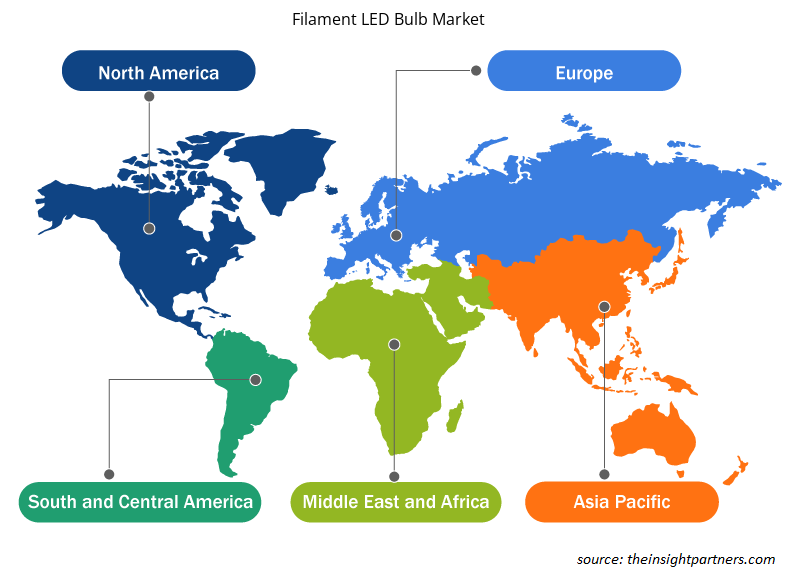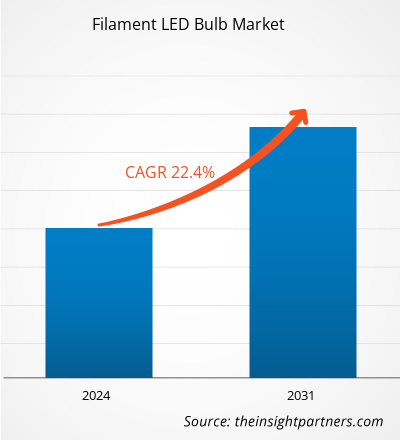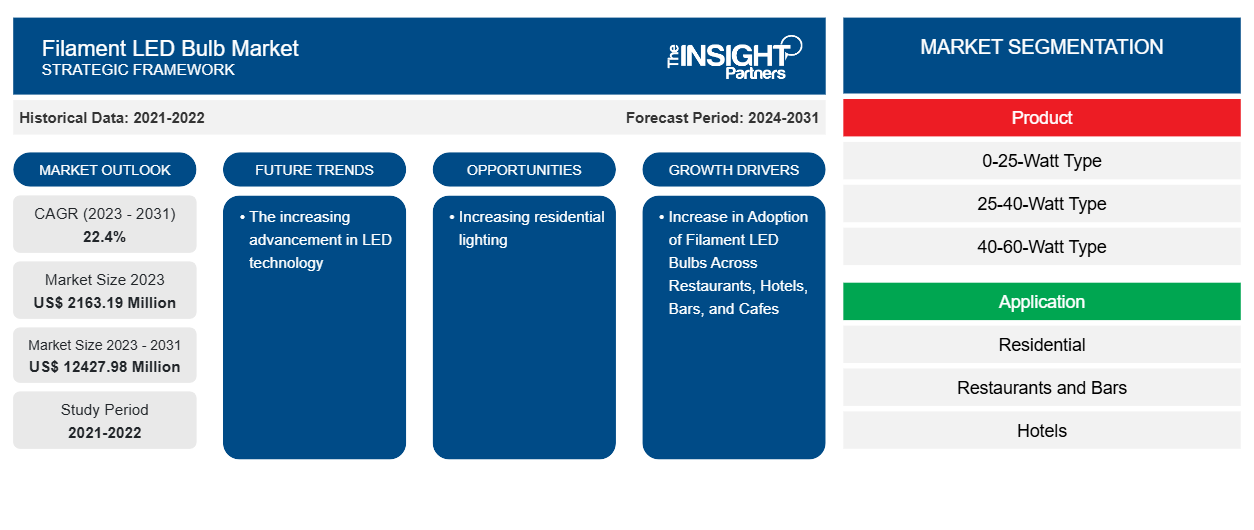Si prevede che il mercato delle lampadine LED a filamento raggiungerà i 12.427,98 milioni di dollari entro il 2031, rispetto ai 2.163,19 milioni di dollari del 2023. Si prevede che il mercato registrerà un CAGR del 22,4% nel periodo 2023-2031. È probabile che il crescente progresso nella tecnologia LED rimanga una tendenza chiave nel mercato.CAGR of 22.4% during 2023–2031. The increasing advancement in LED technology is likely to remain a key trend in the market.
Analisi di mercato delle lampadine LED a filamento
La crescita del mercato è attribuita al crescente numero di progetti di costruzione commerciale e residenziale in diverse regioni. Inoltre, l'aumento dell'interesse per le attività di ristrutturazione e rimodellamento delle case, che può essere collegato al maggiore supporto governativo, in particolare nei paesi industrializzati, sta anche aumentando la domanda di lampadine LED a filamento. L'aumento dei livelli di reddito dei consumatori, i cambiamenti negli stili di vita e l'adozione di culture diverse in termini di arredamento d'interni stanno contribuendo a questa transizione.
Panoramica del mercato delle lampadine LED a filamento
Le lampadine a filamento LED migliorano l'aspetto e la dispersione della luce delle lampadine a incandescenza, utilizzando la tecnologia LED per fornire un'illuminazione efficiente e prestazioni affidabili. Le lampadine a filamento LED, comunemente chiamate lampadine Edison, mostrano grandi filamenti luminosi attraverso involucri di vetro trasparente e assomigliano alle vecchie luci a incandescenza o vintage. Le lampadine a filamento LED offrono l'aspetto delle tradizionali lampadine a incandescenza, offrendo al contempo un'illuminazione a risparmio energetico e tutti gli altri vantaggi dell'illuminazione LED tradizionale. Le lampadine a filamento LED hanno una durata maggiore rispetto alle lampadine a incandescenza.
Personalizza questo report in base alle tue esigenze
Riceverai la personalizzazione gratuita di qualsiasi report, comprese parti di questo report, o analisi a livello nazionale, pacchetto dati Excel, oltre a usufruire di grandi offerte e sconti per start-up e università
-
Scopri le principali tendenze di mercato in questo rapporto.Questo campione GRATUITO includerà analisi di dati che spaziano dalle tendenze di mercato alle stime e alle previsioni.
Driver e opportunità del mercato delle lampadine LED a filamento
Aumento dell'adozione di lampadine LED a filamento in ristoranti, hotel, bar e caffetterie
L'illuminazione è un elemento importante nel design generale di ristoranti e bar. Nei bar, nei ristoranti e nelle caffetterie, l'intensità luminosa di 150 lux è generalmente considerata appropriata. Altre aree richiedono 100 lux, la sezione di conservazione degli alimenti richiede 150 lux, la sezione di lavaggio richiede 300 lux e la sezione di cottura richiede 500 lux. I ristoranti utilizzano quattro tipi di illuminazione: illuminazione generale, illuminazione d'accento, illuminazione decorativa e illuminazione naturale. In un bar o in un ristorante, l'illuminazione generale è l'aspetto più significativo. Un'illuminazione omogenea si ottiene posizionando le apparecchiature di illuminazione in un certo ordine allo stesso tempo. I clienti percepiranno il ristorante come più accogliente se ha una decorazione generale decente. L'illuminazione d'accento può essere utilizzata per attirare l'attenzione sugli aspetti principali o fantasiosi dei ristoranti, tra cui decorazioni, piante, tavoli o merci. L'illuminazione decorativa si riferisce ai componenti di illuminazione che vengono utilizzati per completare il design. L'illuminazione tradizionale e moderna può essere utilizzata per creare un'illuminazione decorativa. Pertanto, le varie tecniche di illuminazione utilizzate nei ristoranti, negli hotel, nei bar e nei caffè stanno favorendo l'adozione delle lampadine LED a filamento, contribuendo così alla crescita del mercato.
Aumento dell'illuminazione residenziale
L'illuminazione sta aumentando nelle aree residenziali. L'uso di lampadine a LED nelle case differisce da altre caratteristiche delle famiglie, come il reddito familiare e la proprietà. Tra le famiglie che guadagnano meno di $ 20.000 all'anno, il 39% ha riferito che le lampadine a LED erano la loro scelta principale per l'illuminazione interna, mentre il 54% delle famiglie che guadagnano $ 100.000 o più all'anno ha utilizzato principalmente lampadine a LED nel 2020. Le lampadine a LED a filamento sono ampiamente utilizzate nelle aree residenziali. Pertanto, la crescente illuminazione residenziale sta generando maggiori opportunità per il mercato delle lampadine a LED a filamento.
Analisi della segmentazione del rapporto di mercato delle lampadine LED a filamento
I segmenti chiave che hanno contribuito alla derivazione dell'analisi di mercato delle lampadine LED a filamento sono il prodotto e l'applicazione.
- In base al prodotto, il mercato delle lampadine LED a filamento è suddiviso in tipo 0-25 watt, tipo 25-40 watt, tipo 40-60 watt e tipo superiore a 60 watt. Il segmento 0-25 watt ha detenuto una quota di mercato maggiore nel 2023.
- In base all'applicazione, il mercato è segmentato in residenziale, ristoranti e bar, hotel, caffetterie e altri.café, and others.
Analisi della quota di mercato delle lampadine LED a filamento per area geografica
L'ambito geografico del rapporto sul mercato delle lampadine LED a filamento è suddiviso principalmente in cinque regioni: Nord America, Asia Pacifico, Europa, Medio Oriente e Africa, e Sud e Centro America.
L'Europa ha guidato il mercato delle lampadine LED a filamento nel 2023. In Europa, come i National Energy Efficiency Action Plans (NEEAP) e i National Energy Efficiency Action Plans (NEEAP), i National Energy Efficiency Action Plans (NEEAP) mirano a promuovere investimenti nella manutenzione e ristrutturazione di edifici residenziali e commerciali. Inoltre, la disponibilità dei consumatori a spendere cifre importanti per lo stile degli spazi abitativi ha attirato la loro attenzione su prodotti per l'arredamento della casa come tappeti e moquette e sistemi di illuminazione avanzati e di stile che migliorano l'aspetto estetico degli interni.NEEAPs) and the National Energy Efficiency Action Plans (NEEAPs), the National Energy Efficiency Action Plans (NEEAPs) aim to promote investments in the maintenance and refurbishment of residential and commercial buildings. Further, consumers’ willingness to spend important amounts on the styling of living spaces has drawn their attention to home furnishing products such as carpets and rugs, and advanced and styled
Approfondimenti regionali sul mercato delle lampadine LED a filamento
Le tendenze regionali e i fattori che influenzano il mercato delle lampadine a LED a filamento durante il periodo di previsione sono stati ampiamente spiegati dagli analisti di Insight Partners. Questa sezione discute anche i segmenti e la geografia del mercato delle lampadine a LED a filamento in Nord America, Europa, Asia Pacifico, Medio Oriente e Africa e America meridionale e centrale.

- Ottieni i dati specifici regionali per il mercato delle lampadine LED a filamento
Ambito del rapporto di mercato sulle lampadine a LED a filamento
| Attributo del report | Dettagli |
|---|---|
| Dimensioni del mercato nel 2023 | 2163,19 milioni di dollari USA |
| Dimensioni del mercato entro il 2031 | 12427,98 milioni di dollari USA |
| CAGR globale (2023-2031) | 22,4% |
| Dati storici | 2021-2022 |
| Periodo di previsione | 2024-2031 |
| Segmenti coperti |
Per Prodotto
|
| Regioni e Paesi coperti |
America del Nord
|
| Leader di mercato e profili aziendali chiave |
|
Densità dei player del mercato delle lampadine LED a filamento: comprendere il suo impatto sulle dinamiche aziendali
Il mercato delle lampadine LED a filamento sta crescendo rapidamente, spinto dalla crescente domanda degli utenti finali dovuta a fattori quali l'evoluzione delle preferenze dei consumatori, i progressi tecnologici e una maggiore consapevolezza dei vantaggi del prodotto. Con l'aumento della domanda, le aziende stanno ampliando le loro offerte, innovando per soddisfare le esigenze dei consumatori e capitalizzando sulle tendenze emergenti, il che alimenta ulteriormente la crescita del mercato.
La densità degli operatori di mercato si riferisce alla distribuzione di aziende o società che operano in un particolare mercato o settore. Indica quanti concorrenti (operatori di mercato) sono presenti in un dato spazio di mercato in relazione alle sue dimensioni o al valore di mercato totale.
Le principali aziende che operano nel mercato delle lampadine LED a filamento sono:
- Lampade Crompton Ltd
- Società anonima Havells India Ltd.
- Illuminazione per i consumatori Wipro
- MEGA-UOMO
- Azienda Osram
- Società di gestione di Signify (Philips)
Disclaimer : le aziende elencate sopra non sono classificate secondo un ordine particolare.

- Ottieni una panoramica dei principali attori del mercato delle lampadine LED a filamento
Notizie e sviluppi recenti sul mercato delle lampadine LED a filamento
Il mercato delle lampadine LED a filamento viene valutato raccogliendo dati qualitativi e quantitativi dopo la ricerca primaria e secondaria, che include importanti pubblicazioni aziendali, dati di associazioni e database. Di seguito sono elencati alcuni degli sviluppi nel mercato delle lampadine LED a filamento:
- Feit Electric Company, Inc. ("Feit Electric"), un marchio leader mondiale nel settore dell'illuminazione e della casa intelligente con sede in California, ha annunciato oggi che una serie di brevetti protegge le sue innovative lampadine con filamenti bianchi visibili, i "brevetti sui filamenti bianchi".
(Fonte: Trellix, comunicato stampa, ottobre 2023.)
- inoltre, a gennaio Life on Products, Inc. ha lanciato altre luci a filamento LED (fonte: PamTen Inc, comunicato stampa, gennaio 2023)
Copertura e risultati del rapporto sul mercato delle lampadine LED a filamento
Il rapporto "Dimensioni e previsioni del mercato delle lampadine LED a filamento (2021-2031)" fornisce un'analisi dettagliata del mercato che copre le seguenti aree:
- Dimensioni e previsioni del mercato delle lampadine a LED a filamento a livello globale, regionale e nazionale per tutti i principali segmenti di mercato coperti dall'ambito
- Tendenze del mercato delle lampadine a LED a filamento e dinamiche di mercato come driver, vincoli e opportunità chiave
- Analisi dettagliata delle cinque forze PEST/Porter e SWOT
- analisi di mercato delle lampadine LED a filamento che copre le principali tendenze del mercato, il quadro globale e regionale, i principali attori, le normative e i recenti sviluppi del mercato
- Analisi del panorama industriale e della concorrenza che copre la concentrazione del mercato, l'analisi della mappa di calore, i principali attori e gli sviluppi recenti per il mercato delle lampadine LED a filamento
- Profili aziendali dettagliati
- Analisi storica (2 anni), anno base, previsione (7 anni) con CAGR
- Analisi PEST e SWOT
- Valore/volume delle dimensioni del mercato - Globale, Regionale, Nazionale
- Industria e panorama competitivo
- Set di dati Excel
Report recenti
Testimonianze
Motivo dell'acquisto
- Processo decisionale informato
- Comprensione delle dinamiche di mercato
- Analisi competitiva
- Analisi dei clienti
- Previsioni di mercato
- Mitigazione del rischio
- Pianificazione strategica
- Giustificazione degli investimenti
- Identificazione dei mercati emergenti
- Miglioramento delle strategie di marketing
- Aumento dell'efficienza operativa
- Allineamento alle tendenze normative























 Ottieni un campione gratuito per - Mercato delle lampadine LED a filamento
Ottieni un campione gratuito per - Mercato delle lampadine LED a filamento